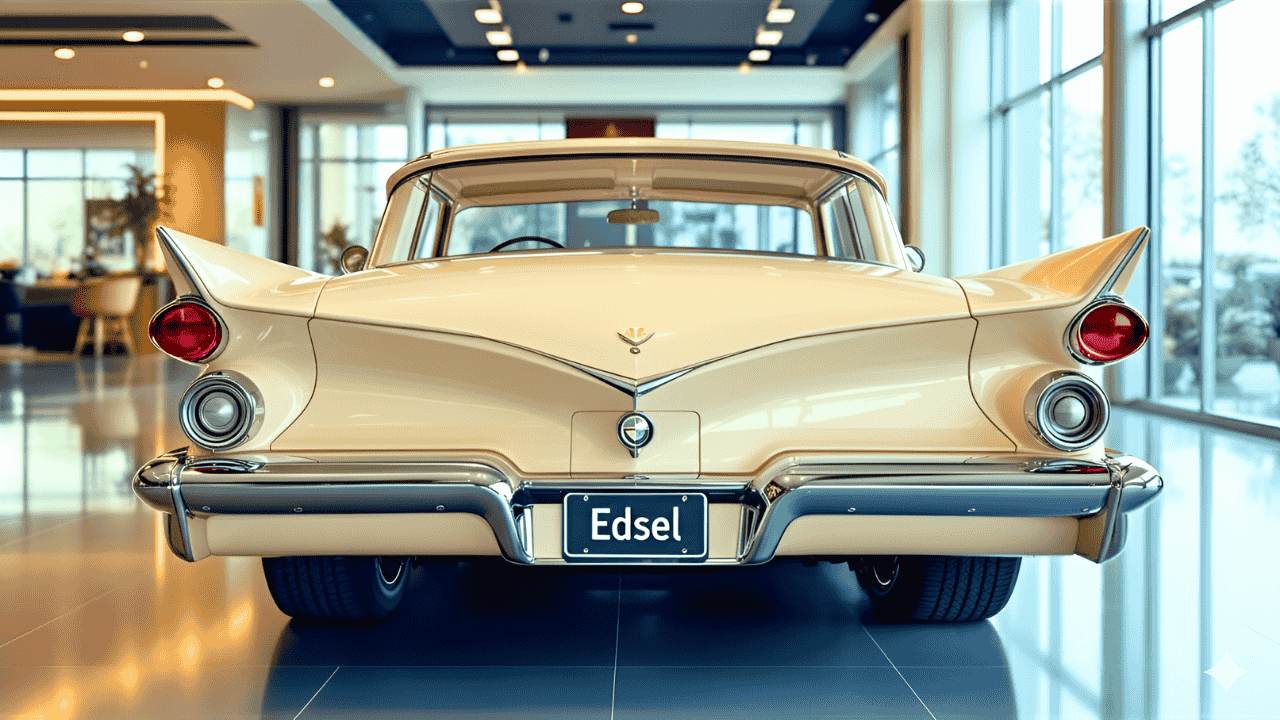When Ford introduced the Edsel Corsair in 1958, it was meant to redefine the American luxury car market. With futuristic styling, advanced engineering, and a strong marketing push, the Edsel lineup including the Corsair was designed to be a brand that stood proudly between Ford and Mercury. Yet, despite all the ambition and hype, the Edsel Corsair turned into one of the biggest failures in automotive history. Today, it remains a fascinating case study in how innovation, timing, and marketing can make or break a car’s destiny.
What is the story behind the creation of the 1958 Edsel Corsair
The idea for the Edsel brand began in the early 1950s when Ford executives noticed that there was a gap between the company’s affordable Ford models and the more upscale Mercury and Lincoln vehicles. To fill this space, Ford planned a completely new division—one that would blend luxury, technology, and distinctive styling. Named after Edsel Ford, the son of company founder Henry Ford, the brand symbolized ambition and innovation.
The Edsel Corsair was one of the upper-tier models in the lineup, positioned just below the top-end Citation. It was based on the Mercury chassis and aimed at buyers who wanted comfort, performance, and style in one package. Ford poured millions into developing the car and promoting it as the future of American motoring. However, what was intended to be a bold leap forward soon became an infamous disaster.
When the 1958 Edsel Corsair was launched and how it was received
The Edsel Corsair made its grand debut on September 4, 1957 an event heavily publicized as “E-Day.” Ford’s marketing machine built massive anticipation, teasing the car’s revolutionary features and promising something unlike anything on the road.
But when the Corsair finally arrived, the reaction was far from what Ford expected. The car’s polarizing design especially its vertical “horse collar” grille instantly divided opinion. Some admired its futuristic look, while others found it unattractive or even bizarre. The styling, intended to stand out, instead alienated many potential buyers.
Even worse, the timing of its release couldn’t have been worse. The United States was entering a recession in 1958, and buyers were turning away from flashy, expensive cars toward smaller, more economical models. The Edsel, with its high price and ambitious image, failed to connect with the mood of the nation.
How the design and features set the Edsel Corsair apart
Despite its commercial failure, the 1958 Edsel Corsair was actually an impressive car from a technological standpoint. It was offered in two body styles a two-door and a four-door hardtop and was powered by a powerful 410-cubic-inch MEL V8 engine producing 345 horsepower. The engine was paired with Ford’s innovative Teletouch automatic transmission, which allowed drivers to shift gears using buttons located in the center of the steering wheel a futuristic idea for its time.
Inside, the Corsair offered a luxurious cabin with premium materials, padded dashboards, and advanced instrumentation. Chrome accents and distinctive trim gave it a sense of elegance that rivaled Cadillac and Chrysler. The car’s suspension and ride quality were also praised for their smoothness, proving that Ford engineers had indeed built a capable luxury car.
However, these innovations came with their own set of problems. The Teletouch transmission system, while innovative, was unreliable and expensive to maintain. Electrical issues, poor assembly quality, and inconsistent dealer service plagued the brand from the start, quickly damaging its reputation.
What went wrong with Ford’s marketing and positioning
One of the biggest reasons behind the Edsel Corsair’s failure was poor marketing. Ford spent enormous sums hyping the Edsel as something completely new, but when customers saw it, they were confused. The car didn’t fit clearly into any segment—it was too expensive for Ford buyers and too unfamiliar for Mercury or Lincoln customers.
The brand also suffered from unclear dealership organization. Some Ford and Mercury dealers refused to carry the Edsel, forcing the company to create a new dealership network that lacked experience and customer trust. To make matters worse, early production cars suffered from manufacturing delays and quality control problems, leading to disappointed buyers right from the start.
How public perception and timing sealed its fate
The public’s first impression of the Edsel Corsair was dominated by disappointment and confusion. While Ford advertised it as a luxury car of the future, many consumers simply didn’t understand what made it different. The unusual styling, combined with a high price tag, made it hard to justify in a market already shrinking due to economic pressure.
In 1958, car buyers were becoming more conservative in their tastes. They wanted reliability and value, not bold experiments. The Edsel arrived at precisely the wrong time. when America was shifting from optimism to caution. Within its first year, sales figures were far below expectations, and Ford began losing confidence in the project.
When Ford decided to end the Edsel experiment
By 1960, after just three model years, Ford decided to pull the plug on the Edsel brand altogether. The company had lost nearly $350 million (equivalent to over $3 billion today) on the project, making it one of the most expensive failures in automotive history. The 1958 Corsair, despite being one of the most advanced models in the lineup, disappeared along with the brand.
However, over time, the Edsel Corsair gained a new kind of fame not as a success story, but as a symbol of overambition and misjudgment. It became a reminder to automakers that understanding the market is just as important as building a great product.
How the 1958 Edsel Corsair became a collector’s icon
Today, the Edsel Corsair has achieved a cult following among collectors and automotive historians. What was once mocked as a failure is now celebrated as a symbol of 1950s innovation and daring design. Its rarity and historical significance make it highly sought after in classic car circles. Well-preserved examples can fetch impressive prices at auctions, not because of their success, but because of the fascinating story they tell.
Enthusiasts admire the Corsair for its boldness, powerful V8 engine, and unique styling that captures the spirit of mid-century America. It represents a time when automakers weren’t afraid to take risks. even if those risks didn’t always pay off.
What the Edsel Corsair teaches about innovation and failure
The story of the 1958 Edsel Corsair is not just about a car. it’s about vision, timing, and understanding people. It shows that even the biggest companies can make mistakes when they misread the market or overestimate demand. Yet, it also reminds us that failure doesn’t erase innovation. The Corsair introduced ideas that would later become standard in the automotive world, from push-button transmissions to advanced comfort features.
More than six decades later, the Edsel Corsair stands as both a cautionary tale and a celebration of creativity. It remains one of the most talked-about cars in history. not for what it achieved, but for the lessons it left behind.
In the end, the 1958 Edsel Corsair was a car ahead of its time. It failed in the market, but it succeeded in becoming a timeless reminder that even bold dreams deserve respect, whether or not they find success on the open road.



